SKODA OCTAVIA 2013 3.G / (5E) Owner's Manual
Manufacturer: SKODA, Model Year: 2013, Model line: OCTAVIA, Model: SKODA OCTAVIA 2013 3.G / (5E)Pages: 287, PDF Size: 18.55 MB
Page 251 of 287
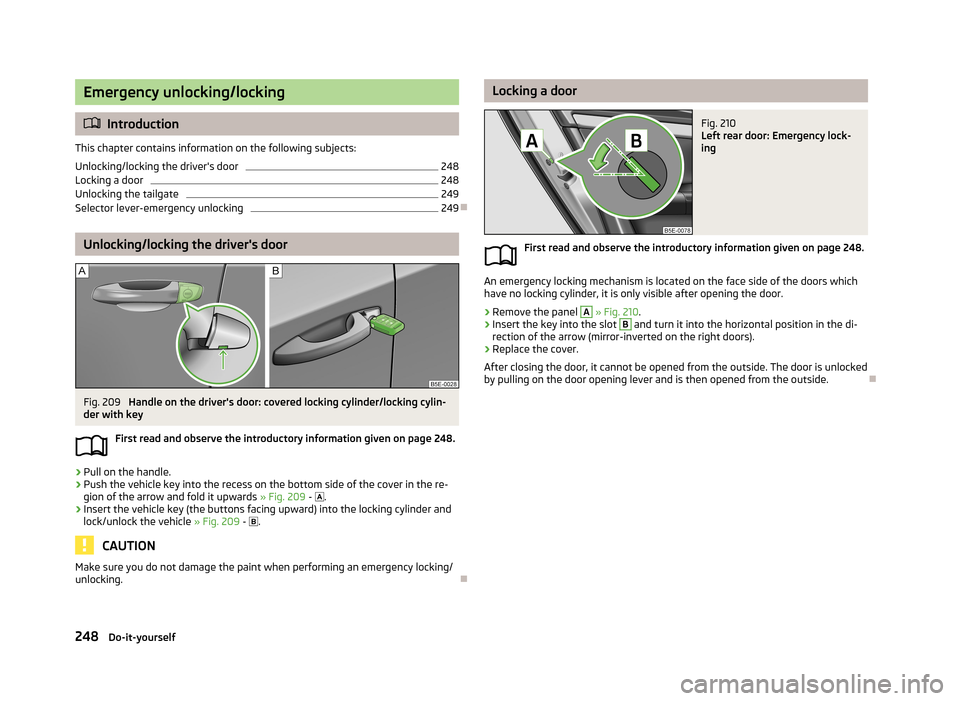
Emergency unlocking/locking
Introduction
This chapter contains information on the following subjects:
Unlocking/locking the driver's door
248
Locking a door
248
Unlocking the tailgate
249
Selector lever-emergency unlocking
249
Unlocking/locking the driver's door
Fig. 209
Handle on the driver's door: covered locking cylinder/locking cylin-
der with key
First read and observe the introductory information given on page 248.
›
Pull on the handle.
›
Push the vehicle key into the recess on the bottom side of the cover in the re-gion of the arrow and fold it upwards » Fig. 209 -
.
›
Insert the vehicle key (the buttons facing upward) into the locking cylinder and
lock/unlock the vehicle » Fig. 209 -
.
CAUTION
Make sure you do not damage the paint when performing an emergency locking/
unlocking.
Locking a doorFig. 210
Left rear door: Emergency lock-
ing
First read and observe the introductory information given on page 248.
An emergency locking mechanism is located on the face side of the doors which
have no locking cylinder, it is only visible after opening the door.
›
Remove the panel
A
» Fig. 210 .
›
Insert the key into the slot
B
and turn it into the horizontal position in the di-
rection of the arrow (mirror-inverted on the right doors).
›
Replace the cover.
After closing the door, it cannot be opened from the outside. The door is unlocked by pulling on the door opening lever and is then opened from the outside.
248Do-it-yourself
Page 252 of 287
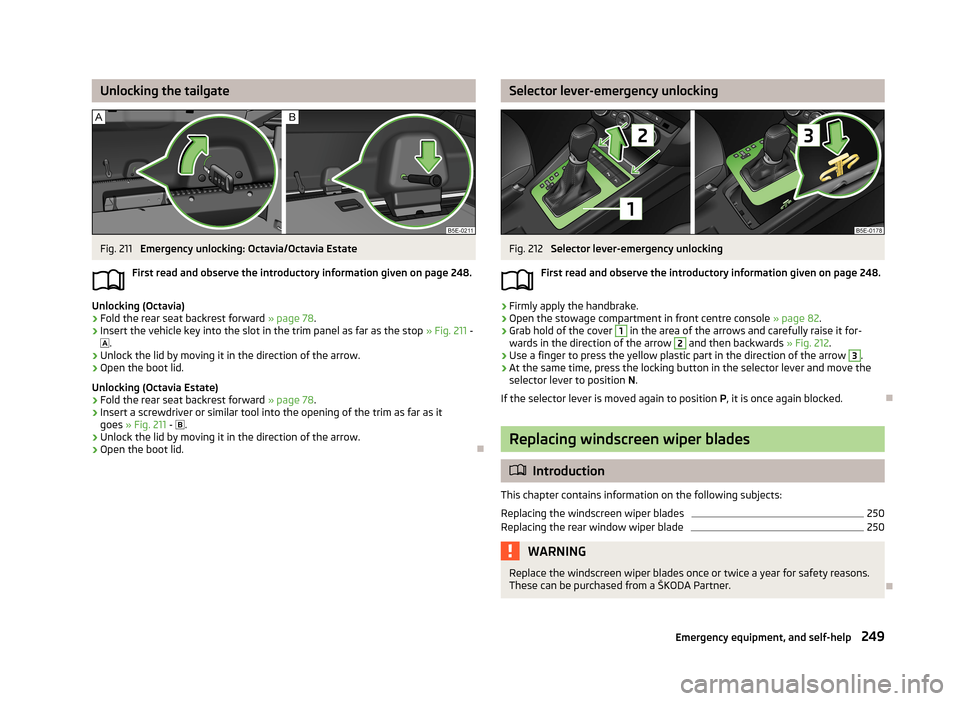
Unlocking the tailgateFig. 211
Emergency unlocking: Octavia/Octavia Estate
First read and observe the introductory information given on page 248.
Unlocking (Octavia)
›
Fold the rear seat backrest forward » page 78.
›
Insert the vehicle key into the slot in the trim panel as far as the stop » Fig. 211 -
.
›
Unlock the lid by moving it in the direction of the arrow.
›
Open the boot lid.
Unlocking (Octavia Estate)
›
Fold the rear seat backrest forward » page 78.
›
Insert a screwdriver or similar tool into the opening of the trim as far as it
goes » Fig. 211 -
.
›
Unlock the lid by moving it in the direction of the arrow.
›
Open the boot lid.
Selector lever-emergency unlockingFig. 212
Selector lever-emergency unlocking
First read and observe the introductory information given on page 248.
›
Firmly apply the handbrake.
›
Open the stowage compartment in front centre console » page 82.
›
Grab hold of the cover
1
in the area of the arrows and carefully raise it for-
wards in the direction of the arrow
2
and then backwards » Fig. 212.
›
Use a finger to press the yellow plastic part in the direction of the arrow
3
.
›
At the same time, press the locking button in the selector lever and move the
selector lever to position N.
If the selector lever is moved again to position P, it is once again blocked.
Replacing windscreen wiper blades
Introduction
This chapter contains information on the following subjects:
Replacing the windscreen wiper blades
250
Replacing the rear window wiper blade
250WARNINGReplace the windscreen wiper blades once or twice a year for safety reasons.
These can be purchased from a ŠKODA Partner.
249Emergency equipment, and self-help
Page 253 of 287
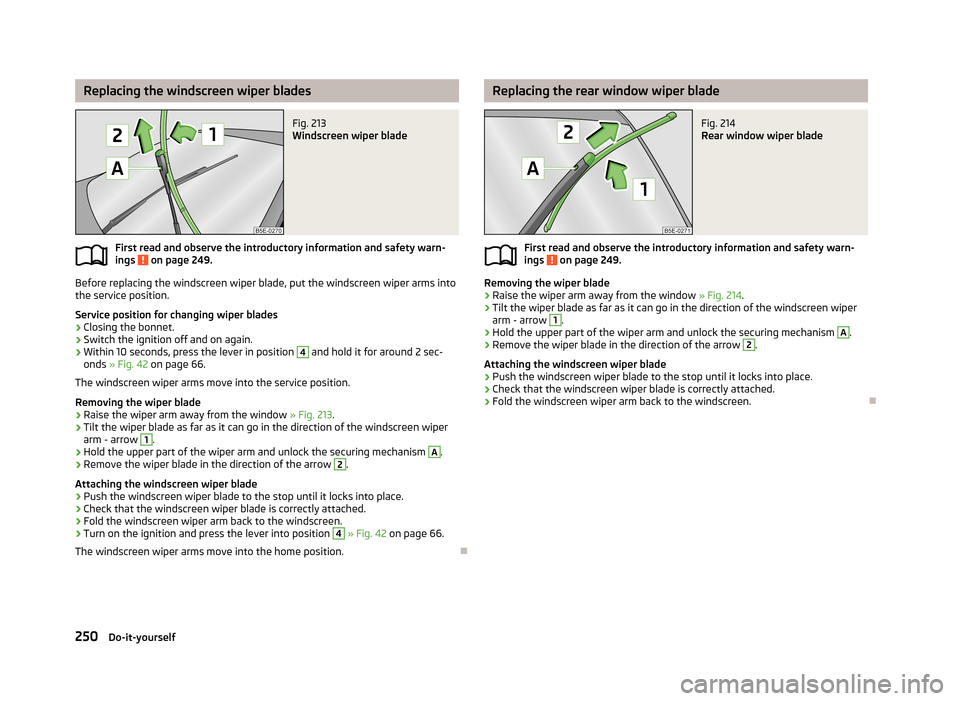
Replacing the windscreen wiper bladesFig. 213
Windscreen wiper blade
First read and observe the introductory information and safety warn-ings on page 249.
Before replacing the windscreen wiper blade, put the windscreen wiper arms into
the service position.
Service position for changing wiper blades
›
Closing the bonnet.
›
Switch the ignition off and on again.
›
Within 10 seconds, press the lever in position
4
and hold it for around 2 sec-
onds » Fig. 42 on page 66.
The windscreen wiper arms move into the service position.
Removing the wiper blade
›
Raise the wiper arm away from the window » Fig. 213.
›
Tilt the wiper blade as far as it can go in the direction of the windscreen wiper
arm - arrow
1
.
›
Hold the upper part of the wiper arm and unlock the securing mechanism
A
.
›
Remove the wiper blade in the direction of the arrow
2
.
Attaching the windscreen wiper blade
›
Push the windscreen wiper blade to the stop until it locks into place.
›
Check that the windscreen wiper blade is correctly attached.
›
Fold the windscreen wiper arm back to the windscreen.
›
Turn on the ignition and press the lever into position
4
» Fig. 42 on page 66.
The windscreen wiper arms move into the home position.
Replacing the rear window wiper bladeFig. 214
Rear window wiper blade
First read and observe the introductory information and safety warn- ings on page 249.
Removing the wiper blade
›
Raise the wiper arm away from the window » Fig. 214.
›
Tilt the wiper blade as far as it can go in the direction of the windscreen wiper
arm - arrow
1
.
›
Hold the upper part of the wiper arm and unlock the securing mechanism
A
.
›
Remove the wiper blade in the direction of the arrow
2
.
Attaching the windscreen wiper blade
›
Push the windscreen wiper blade to the stop until it locks into place.
›
Check that the windscreen wiper blade is correctly attached.
›
Fold the windscreen wiper arm back to the windscreen.
250Do-it-yourself
Page 254 of 287
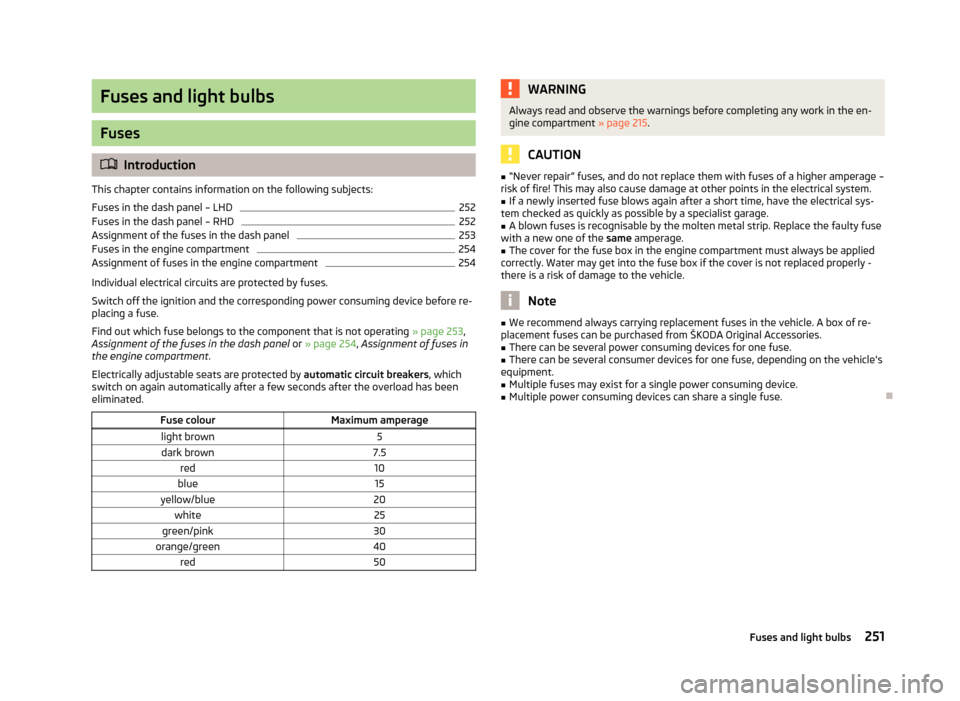
Fuses and light bulbs
Fuses
Introduction
This chapter contains information on the following subjects:
Fuses in the dash panel – LHD
252
Fuses in the dash panel – RHD
252
Assignment of the fuses in the dash panel
253
Fuses in the engine compartment
254
Assignment of fuses in the engine compartment
254
Individual electrical circuits are protected by fuses.
Switch off the ignition and the corresponding power consuming device before re-
placing a fuse.
Find out which fuse belongs to the component that is not operating » page 253,
Assignment of the fuses in the dash panel or » page 254 , Assignment of fuses in
the engine compartment .
Electrically adjustable seats are protected by automatic circuit breakers, which
switch on again automatically after a few seconds after the overload has been
eliminated.
Fuse colourMaximum amperagelight brown5dark brown7.5red10blue15yellow/blue20white25green/pink30orange/green40red50WARNINGAlways read and observe the warnings before completing any work in the en-
gine compartment » page 215.
CAUTION
■
“Never repair” fuses, and do not replace them with fuses of a higher amperage –
risk of fire! This may also cause damage at other points in the electrical system.■
If a newly inserted fuse blows again after a short time, have the electrical sys-
tem checked as quickly as possible by a specialist garage.
■
A blown fuses is recognisable by the molten metal strip. Replace the faulty fuse
with a new one of the same amperage.
■
The cover for the fuse box in the engine compartment must always be applied
correctly. Water may get into the fuse box if the cover is not replaced properly -
there is a risk of damage to the vehicle.
Note
■ We recommend always carrying replacement fuses in the vehicle. A box of re-
placement fuses can be purchased from ŠKODA Original Accessories.■
There can be several power consuming devices for one fuse.
■
There can be several consumer devices for one fuse, depending on the vehicle's
equipment.
■
Multiple fuses may exist for a single power consuming device.
■
Multiple power consuming devices can share a single fuse.
251Fuses and light bulbs
Page 255 of 287
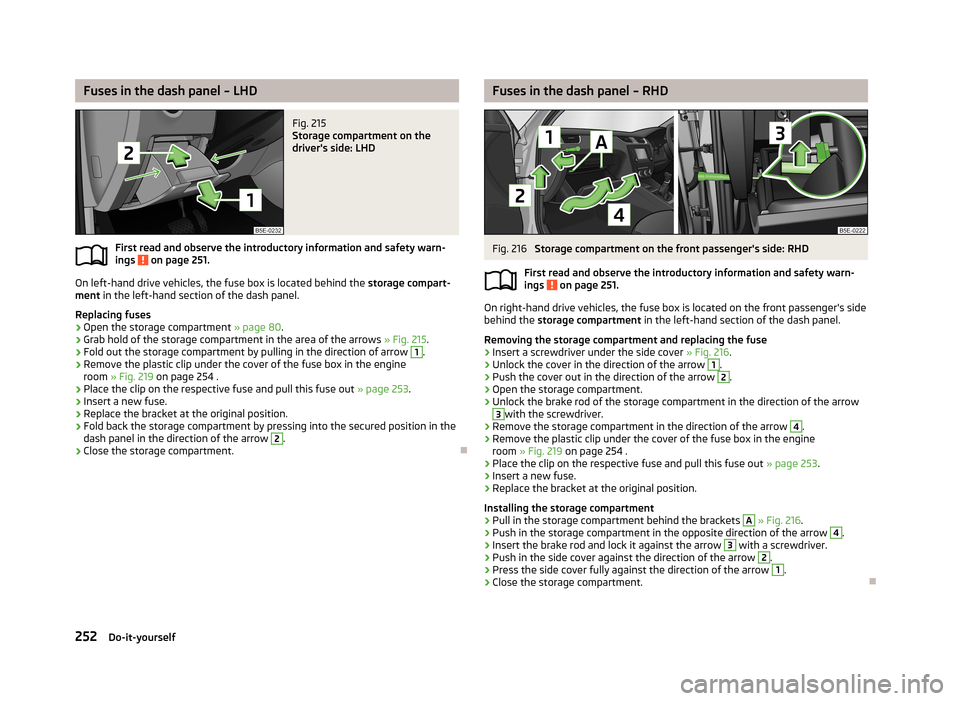
Fuses in the dash panel – LHDFig. 215
Storage compartment on the
driver's side: LHD
First read and observe the introductory information and safety warn-
ings on page 251.
On left-hand drive vehicles, the fuse box is located behind the storage compart-
ment in the left-hand section of the dash panel.
Replacing fuses
›
Open the storage compartment » page 80.
›
Grab hold of the storage compartment in the area of the arrows » Fig. 215.
›
Fold out the storage compartment by pulling in the direction of arrow
1
.
›
Remove the plastic clip under the cover of the fuse box in the engine
room » Fig. 219 on page 254 .
›
Place the clip on the respective fuse and pull this fuse out » page 253.
›
Insert a new fuse.
›
Replace the bracket at the original position.
›
Fold back the storage compartment by pressing into the secured position in the
dash panel in the direction of the arrow
2
.
›
Close the storage compartment.
Fuses in the dash panel – RHDFig. 216
Storage compartment on the front passenger's side: RHD
First read and observe the introductory information and safety warn- ings
on page 251.
On right-hand drive vehicles, the fuse box is located on the front passenger's side behind the storage compartment in the left-hand section of the dash panel.
Removing the storage compartment and replacing the fuse
›
Insert a screwdriver under the side cover » Fig. 216.
›
Unlock the cover in the direction of the arrow
1
.
›
Push the cover out in the direction of the arrow
2
.
›
Open the storage compartment.
›
Unlock the brake rod of the storage compartment in the direction of the arrow
3
with the screwdriver.
›
Remove the storage compartment in the direction of the arrow
4
.
›
Remove the plastic clip under the cover of the fuse box in the engine
room » Fig. 219 on page 254 .
›
Place the clip on the respective fuse and pull this fuse out » page 253
.
›
Insert a new fuse.
›
Replace the bracket at the original position.
Installing the storage compartment
›
Pull in the storage compartment behind the brackets
A
» Fig. 216 .
›
Push in the storage compartment in the opposite direction of the arrow
4
.
›
Insert the brake rod and lock it against the arrow
3
with a screwdriver.
›
Push in the side cover against the direction of the arrow
2
.
›
Press the side cover fully against the direction of the arrow
1
.
›
Close the storage compartment.
252Do-it-yourself
Page 256 of 287
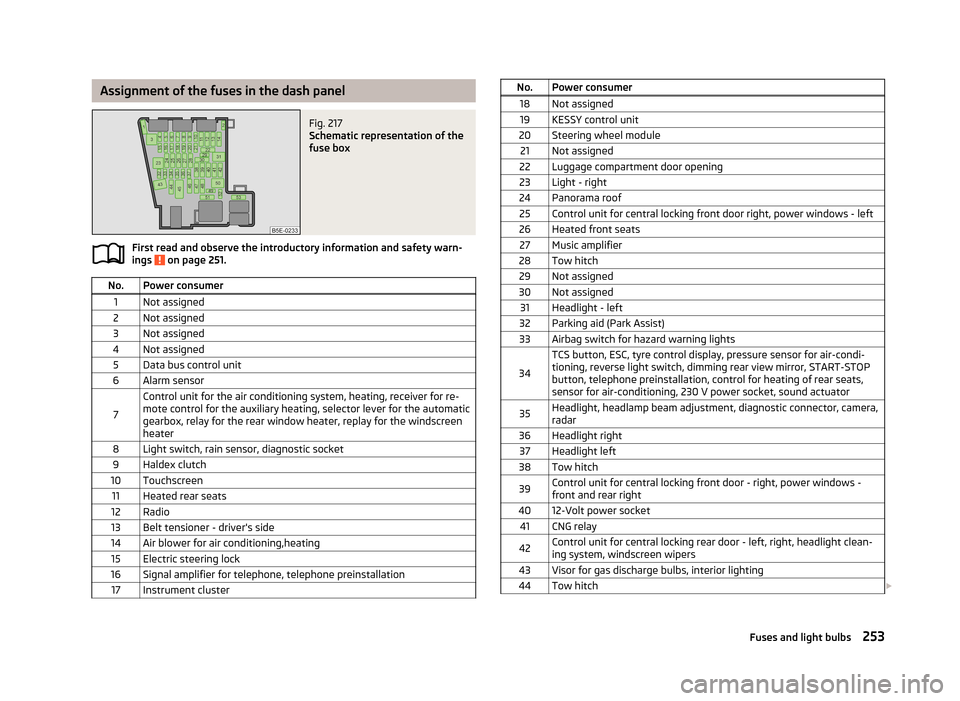
Assignment of the fuses in the dash panelFig. 217
Schematic representation of the
fuse box
First read and observe the introductory information and safety warn-
ings on page 251.
No.Power consumer1Not assigned2Not assigned3Not assigned4Not assigned5Data bus control unit6Alarm sensor
7
Control unit for the air conditioning system, heating, receiver for re-
mote control for the auxiliary heating, selector lever for the automatic gearbox, relay for the rear window heater, replay for the windscreenheater8Light switch, rain sensor, diagnostic socket9Haldex clutch10Touchscreen11Heated rear seats12Radio13Belt tensioner - driver's side14Air blower for air conditioning,heating15Electric steering lock16Signal amplifier for telephone, telephone preinstallation17Instrument clusterNo.Power consumer18Not assigned19KESSY control unit20Steering wheel module21Not assigned22Luggage compartment door opening23Light - right24Panorama roof25Control unit for central locking front door right, power windows - left26Heated front seats27Music amplifier28Tow hitch29Not assigned30Not assigned31Headlight - left32Parking aid (Park Assist)33Airbag switch for hazard warning lights
34
TCS button, ESC, tyre control display, pressure sensor for air-condi-tioning, reverse light switch, dimming rear view mirror, START-STOP
button, telephone preinstallation, control for heating of rear seats,
sensor for air-conditioning, 230 V power socket, sound actuator35Headlight, headlamp beam adjustment, diagnostic connector, camera,
radar36Headlight right37Headlight left38Tow hitch39Control unit for central locking front door - right, power windows - front and rear right4012-Volt power socket41CNG relay42Control unit for central locking rear door - left, right, headlight clean-ing system, windscreen wipers43Visor for gas discharge bulbs, interior lighting44Tow hitch 253Fuses and light bulbs
Page 257 of 287
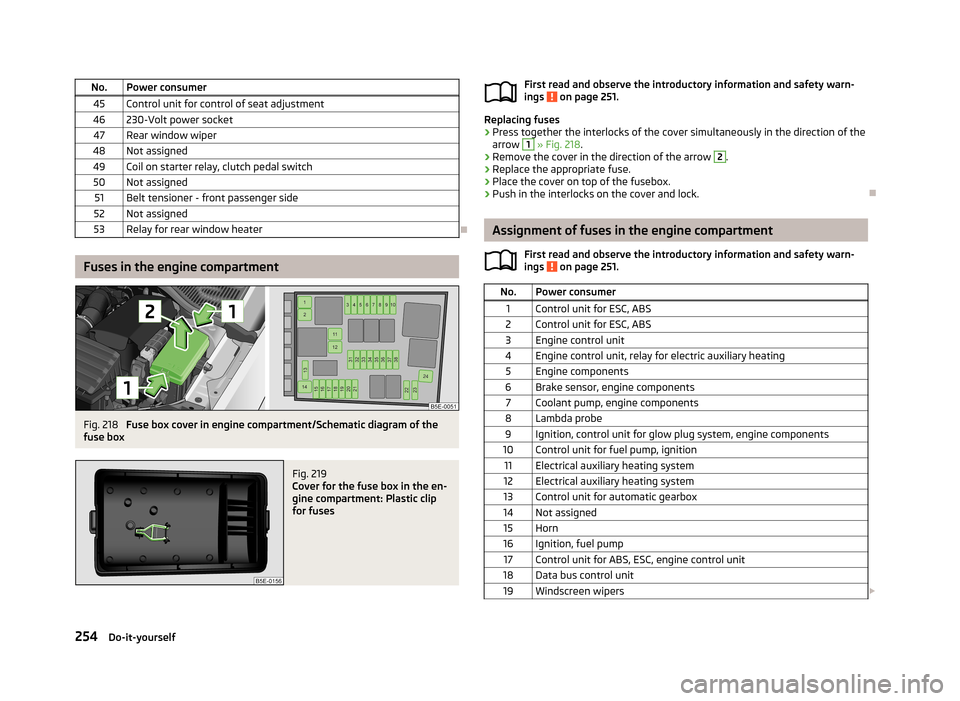
No.Power consumer45Control unit for control of seat adjustment46230-Volt power socket47Rear window wiper48Not assigned49Coil on starter relay, clutch pedal switch50Not assigned51Belt tensioner - front passenger side52Not assigned53Relay for rear window heater
Fuses in the engine compartment
Fig. 218
Fuse box cover in engine compartment/Schematic diagram of the
fuse box
Fig. 219
Cover for the fuse box in the en-
gine compartment: Plastic clip
for fuses
First read and observe the introductory information and safety warn-
ings on page 251.
Replacing fuses
›
Press together the interlocks of the cover simultaneously in the direction of the
arrow
1
» Fig. 218 .
›
Remove the cover in the direction of the arrow
2
.
›
Replace the appropriate fuse.
›
Place the cover on top of the fusebox.
›
Push in the interlocks on the cover and lock.
Assignment of fuses in the engine compartment
First read and observe the introductory information and safety warn-ings
on page 251.
No.Power consumer1Control unit for ESC, ABS2Control unit for ESC, ABS3Engine control unit4Engine control unit, relay for electric auxiliary heating5Engine components6Brake sensor, engine components7Coolant pump, engine components8Lambda probe9Ignition, control unit for glow plug system, engine components10Control unit for fuel pump, ignition11Electrical auxiliary heating system12Electrical auxiliary heating system13Control unit for automatic gearbox14Not assigned15Horn16Ignition, fuel pump17Control unit for ABS, ESC, engine control unit18Data bus control unit19Windscreen wipers 254Do-it-yourself
Page 258 of 287
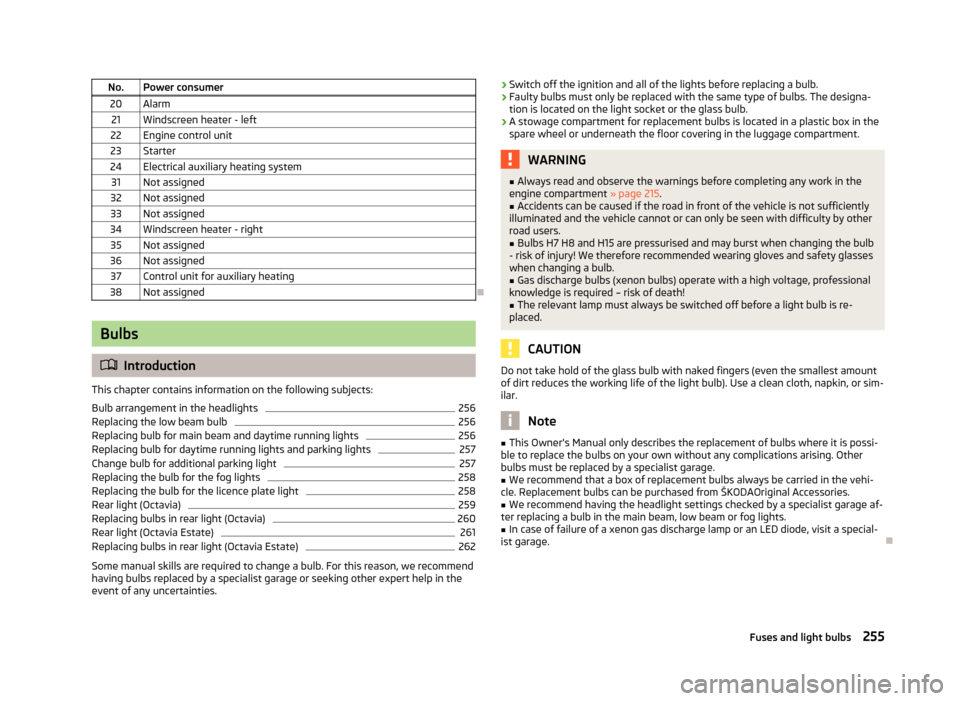
No.Power consumer20Alarm21Windscreen heater - left22Engine control unit23Starter24Electrical auxiliary heating system31Not assigned32Not assigned33Not assigned34Windscreen heater - right35Not assigned36Not assigned37Control unit for auxiliary heating38Not assigned
Bulbs
Introduction
This chapter contains information on the following subjects:
Bulb arrangement in the headlights
256
Replacing the low beam bulb
256
Replacing bulb for main beam and daytime running lights
256
Replacing bulb for daytime running lights and parking lights
257
Change bulb for additional parking light
257
Replacing the bulb for the fog lights
258
Replacing the bulb for the licence plate light
258
Rear light (Octavia)
259
Replacing bulbs in rear light (Octavia)
260
Rear light (Octavia Estate)
261
Replacing bulbs in rear light (Octavia Estate)
262
Some manual skills are required to change a bulb. For this reason, we recommend
having bulbs replaced by a specialist garage or seeking other expert help in the
event of any uncertainties.
› Switch off the ignition and all of the lights before replacing a bulb.
› Faulty bulbs must only be replaced with the same type of bulbs. The designa-
tion is located on the light socket or the glass bulb.
› A stowage compartment for replacement bulbs is located in a plastic box in the
spare wheel or underneath the floor covering in the luggage compartment.WARNING■ Always read and observe the warnings before completing any work in the
engine compartment » page 215.■
Accidents can be caused if the road in front of the vehicle is not sufficiently
illuminated and the vehicle cannot or can only be seen with difficulty by other
road users.
■
Bulbs H7 H8 and H15 are pressurised and may burst when changing the bulb
- risk of injury! We therefore recommended wearing gloves and safety glasses when changing a bulb.
■
Gas discharge bulbs (xenon bulbs) operate with a high voltage, professional
knowledge is required – risk of death!
■
The relevant lamp must always be switched off before a light bulb is re-
placed.
CAUTION
Do not take hold of the glass bulb with naked fingers (even the smallest amount of dirt reduces the working life of the light bulb). Use a clean cloth, napkin, or sim-
ilar.
Note
■ This Owner's Manual only describes the replacement of bulbs where it is possi-
ble to replace the bulbs on your own without any complications arising. Other bulbs must be replaced by a specialist garage.■
We recommend that a box of replacement bulbs always be carried in the vehi-
cle. Replacement bulbs can be purchased from ŠKODAOriginal Accessories.
■
We recommend having the headlight settings checked by a specialist garage af-
ter replacing a bulb in the main beam, low beam or fog lights.
■
In case of failure of a xenon gas discharge lamp or an LED diode, visit a special-
ist garage.
255Fuses and light bulbs
Page 259 of 287
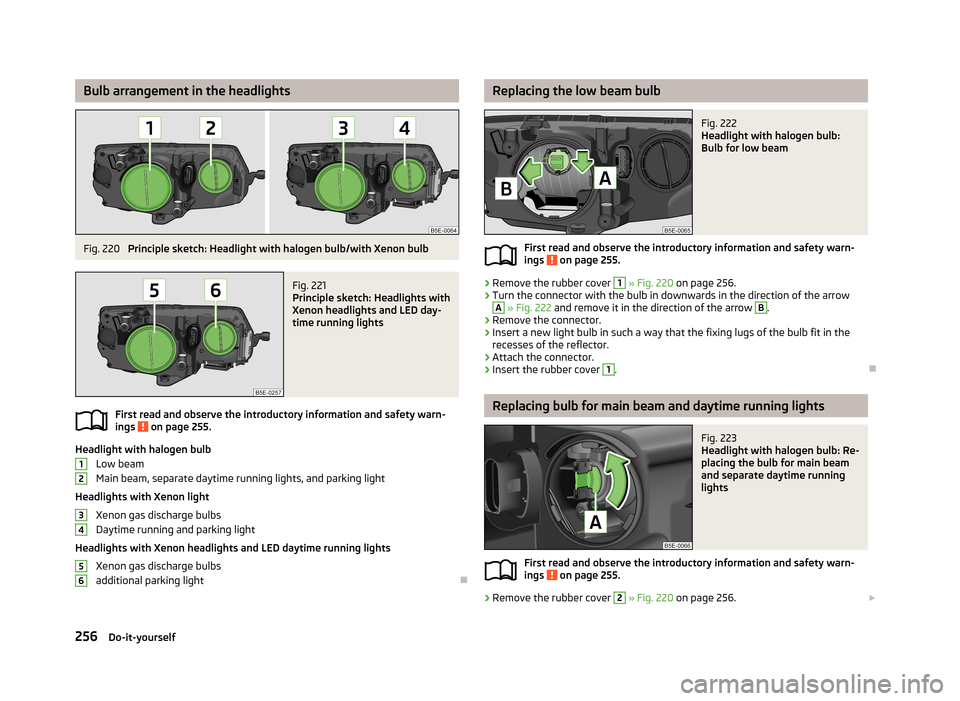
Bulb arrangement in the headlightsFig. 220
Principle sketch: Headlight with halogen bulb/with Xenon bulb
Fig. 221
Principle sketch: Headlights with
Xenon headlights and LED day-
time running lights
First read and observe the introductory information and safety warn-
ings on page 255.
Headlight with halogen bulb
Low beam
Main beam, separate daytime running lights, and parking light
Headlights with Xenon light
Xenon gas discharge bulbs
Daytime running and parking light
Headlights with Xenon headlights and LED daytime running lights Xenon gas discharge bulbs
additional parking light
123456Replacing the low beam bulbFig. 222
Headlight with halogen bulb:
Bulb for low beam
First read and observe the introductory information and safety warn-
ings on page 255.
›
Remove the rubber cover
1
» Fig. 220 on page 256.
›
Turn the connector with the bulb in downwards in the direction of the arrow
A
» Fig. 222 and remove it in the direction of the arrow
B
.
›
Remove the connector.
›
Insert a new light bulb in such a way that the fixing lugs of the bulb fit in the
recesses of the reflector.
›
Attach the connector.
›
Insert the rubber cover
1
.
Replacing bulb for main beam and daytime running lights
Fig. 223
Headlight with halogen bulb: Re-
placing the bulb for main beam
and separate daytime running
lights
First read and observe the introductory information and safety warn- ings on page 255.
›
Remove the rubber cover
2
» Fig. 220 on page 256.
256Do-it-yourself
Page 260 of 287
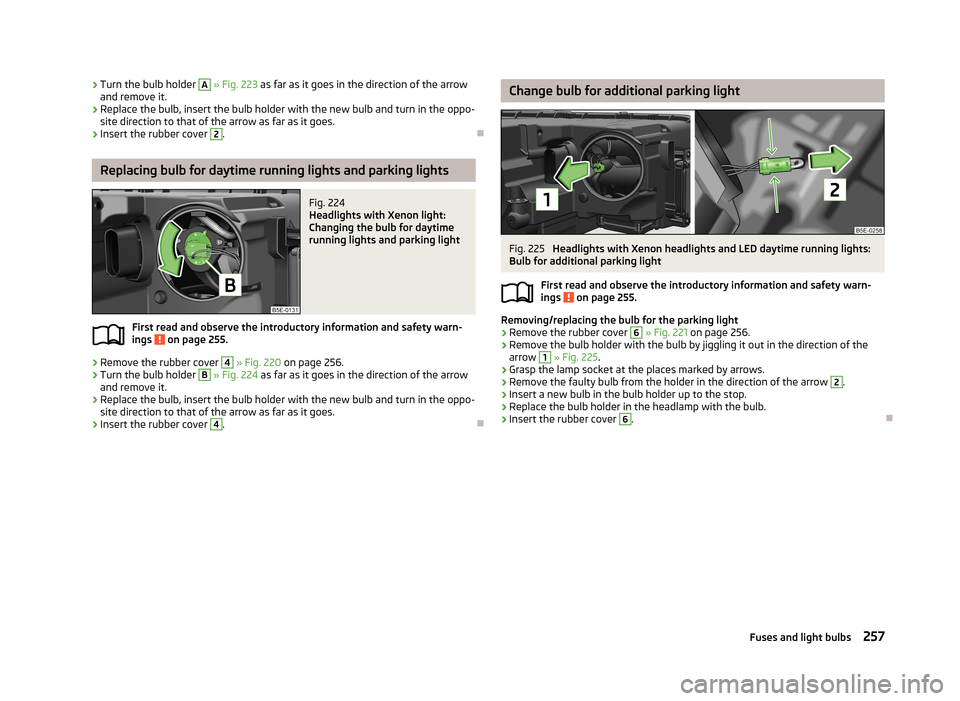
›Turn the bulb holder A
» Fig. 223 as far as it goes in the direction of the arrow
and remove it.›
Replace the bulb, insert the bulb holder with the new bulb and turn in the oppo-
site direction to that of the arrow as far as it goes.
›
Insert the rubber cover
2
.
Replacing bulb for daytime running lights and parking lights
Fig. 224
Headlights with Xenon light:
Changing the bulb for daytime
running lights and parking light
First read and observe the introductory information and safety warn-
ings on page 255.
›
Remove the rubber cover
4
» Fig. 220 on page 256.
›
Turn the bulb holder
B
» Fig. 224 as far as it goes in the direction of the arrow
and remove it.
›
Replace the bulb, insert the bulb holder with the new bulb and turn in the oppo-
site direction to that of the arrow as far as it goes.
›
Insert the rubber cover
4
.
Change bulb for additional parking lightFig. 225
Headlights with Xenon headlights and LED daytime running lights:
Bulb for additional parking light
First read and observe the introductory information and safety warn-
ings
on page 255.
Removing/replacing the bulb for the parking light
›
Remove the rubber cover
6
» Fig. 221 on page 256.
›
Remove the bulb holder with the bulb by jiggling it out in the direction of the
arrow
1
» Fig. 225 .
›
Grasp the lamp socket at the places marked by arrows.
›
Remove the faulty bulb from the holder in the direction of the arrow
2
.
›
Insert a new bulb in the bulb holder up to the stop.
›
Replace the bulb holder in the headlamp with the bulb.
›
Insert the rubber cover
6
.
257Fuses and light bulbs